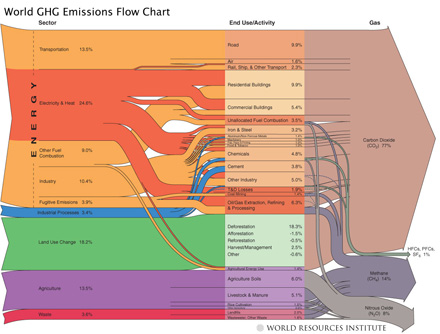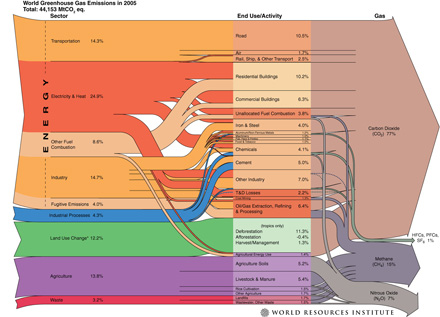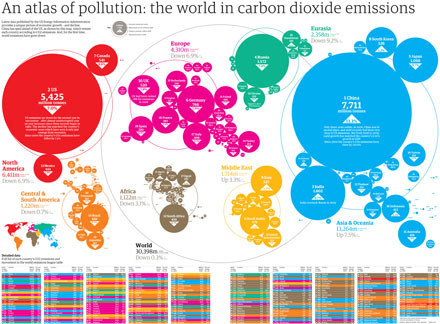I didn’t know that I, or rather the per-capita-USA-citizen I, put eighteen tons of CO2 into the atmosphere last year. 36,000 pounds. Just me.
Following up on our last infographic flowchart, above is a rendering of greenhouse gas flows worldwide for 2000 from UNEP, the United Nations Environment Programme. Click to enlarge.
And here is the data from 2005, via the World Resources Institute. The linked page highlights the changes between 2000 and 2005. Worldwide, CO2 emissions went up 12% – not good – although domestic emissions look very stable in that graphic compared to some of the rest of the world.
It’s not easy to find clearly-presented data about the change in global GHG emissions by sector over time, although Wiki has some ugly but nevertheless alarming charts of the amounts of individual GHG molecules in the atmosphere year-by-year. [bd-MAP is built on a belief that ugly graphics do not inspire confidence.] According to the above flowcharts, residential and commercial building contributions went up, but only about a percentage point in 2005.
The intrepid reporters of The Guardian have done their homework. Their data is current, informative and surprising. And as we have come to expect from The Guardian, well-presented.
CO2 emissions for 2010 have – why are we not surprised? – broken all previous records at thirty-six billion tons. Twenty percent of that natural gas, and of the remaining eighty percent, thirty-six percent from burning oil, and forty-four percent, or sixteen billion tons, from burning coal.
According to Architecture 2030, in the US, buildings account for 50% of both CO2 emissions and energy consumption, and 77% of electricity use. I can’t fully reconcile those numbers with the charts above, but nevertheless, current building stock represents a staggering energy appetite, with deplorable political, economic, ecological, and humanitarian consequences compared to, let us say, structures with half that impact.
Architecture 2030 holds that by 2035, 75% the US building stock will be either new or renovated, and therein lies an incredible opportunity. We architects need to get to work.
Buildings are the problem. Buildings are the solution.
More at Architecture 2030.


